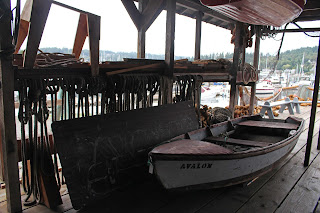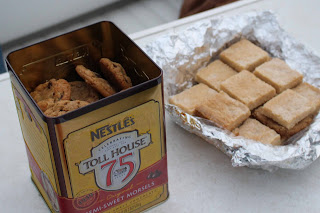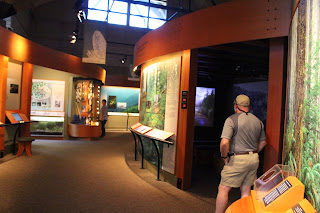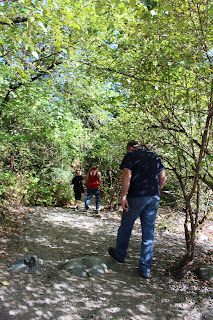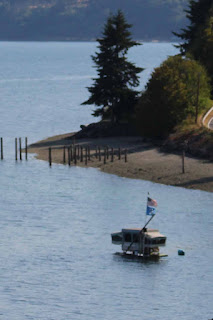NOTE: Best to view blog on computer, however to
view full blog on phone scroll to bottom of the blog and click on “View Web
Version”. Be sure to click on the RV Schedule tab at the top of the page in the
menu bar to see where we will be. You can also enlarge the google map in the
sidebar on the right and click on the markers to view where we have been. If
you want to meet up with us, see the RV Schedule and let us know so we can
spend some time with you!
Gig
Harbor RV Resort, Gig Harbor, WA
We left Coeur
D’Alene, Idaho on August 8, 2015 and arrived at the Gig Harbor RV Resort for 15
days. We planned our schedule to meet Steve and Joanne, our RV friends from Ft.
Worth, Texas. They stayed a week and it was fun to share our adventure with
them! We had a nice long and wide spot at the RV park and Joanne and Steve were
in a nice shaded spot behind us. Tall pine trees towered over us.
When Joanne and
Steve arrived, we all had dinner at their place. Joanne made a delicious
Mexican dip for starters. Sharon made glazed chicken thighs, quinoa, and
stuffed tomatoes. And for dessert, Joanne made a blackberry cobbler with
blackberry’s they picked that day coupled with a cappuccino! It was a great
time!
Another evening we
had a picnic at our RV. For dinner, Mike grilled out tenderloin steaks with a
chipotle rub, Sharon made a strawberry and cashew tossed salad with homemade
poppy seed dressing, along with Joanne’s roasted salted red potatoes. And for
dessert, we had more of Joanne’s blackberry cobbler!
To get to Gig
Harbor you must cross the Tacoma Narrows Bridge, paying a toll only when you
exit! The suspension bridge that spanned the Tacoma Narrows strait of Puget
Sound between Tacoma and the Kitsap Peninsula opened to traffic on July 1,
1940. But on November 7 of the same year faulty design and high winds caused
the bridge to dramatically collapse into Puget Sound. It was the third longest
suspension bridge in the world in terms of main span length, behind the Golden
Gate Bridge and the George Washington Bridge.
Following the collapse, the United States’ involvement in World War II delayed plans to replace the bridge. The portions of the bridge still standing after the collapse, including towers and cables, were dismantled and sold as scrap metal. Nearly 10 years after the bridge collapsed, a new Tacoma Narrows Bridge opened in the same location, using the original bridge’s tower pedestals and cable anchorages.
Gig
Harbor
We picked Gig
Harbor because of its central location. There was so much to do in the area,
but so little time! Known as the most picturesque harbor in the Northwest, Gig
Harbor spills down a hillside to a sailboat and yacht-dotted harbor. Gig Harbor is a spectacular setting rimmed by
an evergreen forest. The town is quaint with lots of restaurants, a trolley and
unique boutique shops around every corner! It was named one of Smithsonian
Magazine’s Top Five Small Towns for culture, heritage and charm.
The most interesting stop was the Skansie Park Net Shed where we learned all about the maritime history of Gig Harbor. This was just one of 17 historic net sheds that remain on all of Puget Sound. Other than Skansie Park Net Shed, all net sheds are privately-owned and not open to the public.
Net sheds
represent one of Gig Harbor’s most notable and colorful industries: commercial
fishing. Around the turn of the century, immigrants from Croatia began building
modest docs with covered sheds on wood pilings along the shoreline. The net
sheds provided easy access to load and unload their nets and gear.
In the late 1880’s
the life of a fisherman was hard. Their livelihood depended on fishing for
salmon from small wooden boats in open waters.
There were no skiff engines or powered “blocks” to hoist up their gear.
The men used oars and cotton net was pulled in by hand. To lengthen the life of
the “web,” net was dipped in hot tar from pots heated over wood fires,
stretched out to dry and finally, stored in net sheds. At the end of each
season and to prevent rot, it was rinsed in “bluestone,” a copper sulphate
preservative and hung to dry. By the 1940’s, nylon replaced cotton nets, and
gas-powered engines replaced the brute strength of the crew.
After our tour of the Skansie Park Net Shed, Mike and I enjoyed eating at
The Net Shed No. 9, a
new restaurant down the street. It was delicious!
One evening while
Mike and Steve occupied themselves, Joanne and Sharon took their bag chairs and
went to the Summer Sounds Concert at Skansie Park along the harbor. Austin
Jenckes has lyrical roots in country and folk, and an unmistakably unique vocal
style. He is a singer/songwriter with the voice of an honest soul! Austin
played for a packed audience. Austin was a contestant on Blake Shelton’s team
on The Voice! Listen to the video of Austin singing "Higher."
Another day while walking through town, Steve and Joanne and us had lunch at the historic Tides Tavern that served local shellfish, and an array of other meals including hamburgers, pizza and sandwiches. The building was built by Axel Uddenberg in 1910 and served the area as a general store. Located next to the “People’s Dock,” the town’s only public ferry landing, it was called the West Side Mercantile. After going through a series of owners the building was run down and in a state of disrepair. It was bought by Peter Stanley in 1973. After an extensive and ambitious rebuilding project, the Tides opened its doors to the public in June, 1973.
The night before
Steve and Joanne left for their next destination, we had dinner and drinks on
the deck of the Anthony’s Restaurant overlooking the harbor. We toasted to our
time together and made plans to see them in Texas the next time we were there!
Poulsbo
There was a town
just north of Gig Harbor called Poulsbo, commonly referred to as “Little Norway
on the Fjord.” Poulsbo is nestled in a
valley between the majestic Olympic and Cascade Mountain ranges. We took a drive one day to stroll the streets
of this Norwegian-inspired town. Like most small towns, it had its share of art
galleries with local artwork, craft breweries and shopping, all on a charming
main street that paralleled the harbor.
On our ongoing quest to find a cinnamon bun as delicious as the one had on the Turquoise Trail in New Mexico, we enjoyed a stop at the local world-famous bakery to try their cinnamon bun. It was good, but still no match!
On our ongoing quest to find a cinnamon bun as delicious as the one had on the Turquoise Trail in New Mexico, we enjoyed a stop at the local world-famous bakery to try their cinnamon bun. It was good, but still no match!
Ferry to Seattle
We were told by
many people that you don’t want to drive in Seattle. So luckily we were able to
reserve a ferry ride out of Bremerton, just north of Gig Harbor. Mike was a little under the weather, so he took a snooze on the ferry ride over to Seattle.
Once we docked, we headed toward the World Famous Pike Place Fish Market in Seattle’s 107-year old Public Market. In 1986, when the fish company was on the verge of bankruptcy, owner, John Yokoyama enlisted a company to coach him and the fishmongers in developing an empowering company culture. Today, Pike Place Fish continues to generate record-breaking performances in sales and profitability. Not only that – its fish-throwing staff have been featured in People’s Magazine, Fast Company Magazine, Free Willy (the movie), ESPN, Good Morning American, CBS’s Sunday Morning and many more! Their company’s work culture has become a favorite subject for case studies in business schools and have become a legend in the corporate training industry.
We enjoyed wandering through the Public Market with stalls full of fresh-cut flowers, handmade artisan wares, and fresh fruits and vegetables. There was no shortage of coffee and breweries.
We then rode the Seattle Center Monorail which was built for the 1962 Seattle World’s Fair. It’s the fastest way to get to the Seattle Center to see the Space Needle where you can take a 41-second ride to the top of this 605-foot tall symbol of Seattle.
We listened to Feed the Frog Jazz Band!
We also toured the Chihuly Garden and Glass. The exhibition includes both indoor and outdoor spaces packed with thousands of Dale Chihuly’s masterpieces and the Glasshouse with a 100-foot-long suspended sculpture! A true Northwesterner, Dale has pioneered new techniques in art and influenced generations of artists. His large-scale blown glass sculptures are exhibited in museums and hotels around the world.
Afterwards we walked through the downtown, up and down steep hills! We then walked a few of the Piers along the waterfront and saw the Great Ferris Wheel that weighs 280,300 pounds, stands 175 feet high and extends 40 feet beyond the end of Pier 57 over Elliott Bay. Its foundation consists of 550 tons of concrete! It was time to catch our ferry ride back to Bremerton. It was a fun day in Seattle!
Tree House Point in Issaquah, Washington
Dan, a good friend
back home told us about the realty show “Treehouse Masters” on Animal Planet
which features Pete Nelson crafting custom-built treehouses. In 2006, he opened
an inn of his own in Issaquah, Washington, called Tree House Point, where you
can stay in one of six 200-square foot cabins built around a Sitka spruce or
red cedar. Tree House Point is a romantic bed and breakfast retreat with a Main
Lodge for eating, lounging and relaxing. Read about his story and Tree House
Point at www.treehousepoint.com. All treehouses are heated, have electricity, and are well
designed and artfully decorated with touches like handmade beds, original art
and charming vintage furnishings. Tree
House Point offered guided tours of the six guest room treehouses, so we
scheduled a tour for Steve, Joanne and us!
We were surprised at how many people showed up. We were in one group of probably four groups that meandered through the dense old growth forest on the Raging River in the Snoqualmie Valley. With a little forethought, this could have made a memorable anniversary celebration! It was an amazing experience, although Sharon did get a little dizzy walking on the rope bridge to the last treehouse!
It was meant to
be! You may remember from our blog on Jackson Hole that we met Laura and her
two grandsons from Olympia, Washington, and her daughter from Jackson Hole
while on a covered wagon, dinner and show. We struck up a friendship and Laura
invited us to visit with her and her husband when we got to Washington. So we
did!
They invited us to join them and their friends on their boat out for a sunset cruise and grilled salmon dinner on Puget Sound!
As we motored out across Puget Sound we noticed the beautiful real estate along its shores and points. Steve enjoyed sharing the history of the area with Mike, while the rest of us talked and shared stories.
I made my warm cranberry, praline pecans and goat cheese Quinoa. Laura made a tasty slaw dish and Steve grilled up some of the best salmon we have ever tasted and Halibut as well, equally delicious!
After dinner, Laura and her friend offered up dessert. The chocolate chip cookies were awesome and Laura’s 100 year old shortbread recipe from Scotland, melted in your mouth! I was totally surprised when Laura later gave me the secret recipe of which I have baked and enjoyed many times since then!
Before we headed back to the dock, we got a glimpse of the spectacular 14,410 foot Mount Rainier cloaked beneath the clouds, and we all sat back to enjoy the shimmering Puget Sound and the brilliant sunset.
Laura and Steve were such gracious hosts, inviting us into their home after our dinner cruise on Puget Sound. Their home was a beautiful place with an inviting backyard especially for birds! Their home was tastefully decorated with furniture and other art handcrafted by Steve in his man cave woodworking shop! For a chance meeting in Jackson Hole, this turned out to be an unexpected excursion on our Washington adventure! As a parting gift, they gave us some of Steve’s special crab cakes that we would enjoy later! We hope to look them up again the next time we are in Washington!
Mount
St. Helens National Volcanic Monument
We didn’t want to
leave Washington without seeing Mount St. Helens – the craggy volcanic mountain
that famously blew its top in 1980. This year it celebrated the 35th
Anniversary of the volcanic eruption. The eruption sent 540,000 tons of ash
rocketing into the stratosphere. Ash was measurable more than 900 miles to the
east and trace amounts circled the earth in 10 days.
Today, forests that were leveled in 1980 are teaming with new life, including the recovering blast zone which has become one of the most diverse and production ecosystems in the Pacific Northwest. Below is a postcard that shows Mount St. Helens from the north as seen reflected in the waters of Spirit Lake.
There are four visitor centers to visit. Be sure to watch the widescreen presentation at the Johnston Ridge Observatory. This visitor center offers live seismographs, geologic exhibits, eyewitness accounts, ranger talks, and a bookstore.
Our photos below overlook the crater and show the view of the lava dome and growing glacier from the Johnston Ridge Observatory.
Jewelry Class in Tacoma
For Sharon’s
belated birthday present, Mike got her a one day private metalsmithing class
with Tacoma Metal Arts Center owner, Amy. Sharon was excited to design and
create a sterling silver ring set with the turquoise gemstone we got while in
Santa Fe, New Mexico. It was a fun day and Amy was a patient and knowledgeable
instructor.
Another day we went into Tacoma to do some errands and someone told us about a restaurant called Engine 9. So we stopped at this old fire house and enjoyed lunch!
Deep in the woods
of Point Defiance Park is the Fort Nisqually Living History Museum. Built in 1833, Fort Nisqually was the first
Euro-American settlement on Puget Sound.
Fort Nisqually was established by the Hudson’s Bay Company in 1833 as a fur trading post as well as an agricultural outpost for subsistence farming. By 1855, the date the museum portrays, American territory surrounded this British establishment and the fort faced increasing pressure from American settlers looking to take advantage of the land. The focus of the fort’s operations shifted from fur trade and subsistence farming to commercial agricultural enterprises. Cattle, sheep and horses along with crops such as wheat, barley, rye and peas across 160,000 acres. Scottish-born physician William Fraser Tolmie, an officer of the Hudson’s Bay Company with the rank of Chief Factor, managed Fort Nisqually and the surrounding farms.
Two of the fort’s original structures – the Factor’s House and the Granary – were relocated to Point Defiance Park for preservation during the 1930s. The Factor’s House was built for Dr. Tolmie and his growing family. His house was built in 1855 in the new “Yankee Style” instead of the standard post-in-sill, heavy-timber style used in the majority of Fort Nisqually’s other structures.
Mike had remembered reading something about the marks on the old blankets. These were Hudson Bay Point blankets. Each black line sewn into the blanket represented a point, which denoted the size and how many pelts the blanket was worth.
The stockades, bastions, sales shop, blacksmith shop, laborers’ house, kitchen and heirloom garden have been reconstructed to reflect how Fort Nisqually appeared in the 1850s. The fort stands today as a memorial to the servants of the honorable company of gentlemen out of Hudson’s Bay who risked their “hides for skins” in the Pacific Northwest.
When we made our
initial plans to go to Washington, we were going to visit Sharon’s brother,
John. But several months earlier, he passed away unexpectedly. Here is an undated photo of John and Sharon's sister, Lori, before they went gliding in Arizona. Sharon's sister, Lori has also passed away.
Regretfully we were unable to see John, so our plan was to meet with his close friends, Cleve, Tina and their grandson, Allan. We met at Starbucks where we looked at photos and shared memories. We then drove to Kanaskat-Palmer State Park, a 320-acre park on a small, low plateau in a natural forest setting in the Green River Gorge. We found a secluded, beautiful spot along the shore where we skipped rocks, laughed and said a few words before we each scattered John’s ashes into the Green River.
Regretfully we were unable to see John, so our plan was to meet with his close friends, Cleve, Tina and their grandson, Allan. We met at Starbucks where we looked at photos and shared memories. We then drove to Kanaskat-Palmer State Park, a 320-acre park on a small, low plateau in a natural forest setting in the Green River Gorge. We found a secluded, beautiful spot along the shore where we skipped rocks, laughed and said a few words before we each scattered John’s ashes into the Green River.
Since then we have also scattered John's ashes in the Pacific Ocean off the Oregon Coast, the Atlantic Ocean off of St. Augustine, Florida, and in the Gulf of Mexico in Sarasota, Florida. He can now be free to travel across oceans, around the world, with the ebb and flow of the tide, for an eternity.
Floating Pop-up Tent Camper Adrift in Puget Sound
While driving
along a country road in Olalla we passed by this floating tent camper with two Seahawks
painted on the front and an American flag. We thought it was very unusual. How
does the owner get full hook-ups (water, sewer and electricity)! We thought he was camping!
That was before we knew the real story! Several months later we heard on the news that the camper started its impromptu voyage in Olalla (where we saw it), and belongs to an Olympia man who told Coast Guard members that “it’s gone adrift before.” It was spotted floating in ferry lanes near Vashon Island in October. Coast Guard officials checked it out but no one was inside, and determined the trailer wasn’t a hazard, but it wasn’t safe for them to tow the floating camper back to shore. They said it was up to the owner to retrieve it, but they’d send out alerts to boaters to be aware. The trailer was situated atop an impressive floating platform. Two large Seahawks were painted on wood panels, and was complete with an umbrella, lifeguard chair, and American flag.
So the trailer continued its voyage but it finally came to an end on Kingston beach. The owner will have to secure a boat to reach the wreckage and clean up the debris.
We would love to return to Washington again someday to take the ferry from Port Angeles to Victoria, British Columbia’s inner harbor for a day. And we missed hiking in Mount Rainier and kayaking around Bainbridge Island! And Olympic National Park which has the country’s largest herd of elk. And so much more, including the Cascade Loop Scenic Highway, all of the lighthouses along the Pacific Ocean shorelines, and Orca sightings in the Salish Sea! It’s an adventure for another day!
We are headed to Portland,
Oregon area next to explore the Columbia River Gorge. Stay tuned for our next
blog post!
Mike & Sharon
“Life is a
journey, not a destination; and happiness is not “there” but here; not
tomorrow, but today.”
Sidney Greenberg















